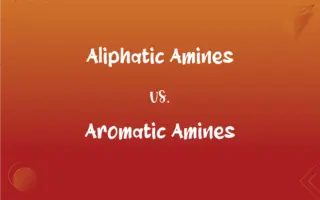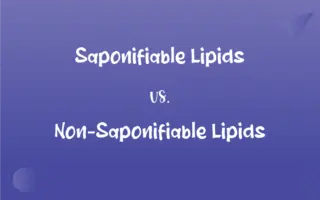Complementation vs. Epistasis: What's the Difference?
Edited by Aimie Carlson || By Janet White || Published on February 28, 2024
Complementation refers to interaction of non-allelic genes to produce a phenotype. Epistasis refers to one gene's effect masks another gene's effect.

Key Differences
Complementation occurs when two different genes interact to produce a phenotype, with each gene complementing the other's lack of functionality. Epistasis involves the interaction where one gene's expression suppresses or masks the effect of another gene.
In complementation, the presence of a functional allele in one gene can compensate for a non-functional allele in another, leading to a normal phenotype. In epistasis, however, a gene at one locus overrides or hides the expression of a gene at a different locus.
Complementation is often used in genetic analysis to determine if mutations are in the same or different genes. Epistasis is used to understand gene interaction pathways and hierarchies in genetic regulation.
A classic example of complementation is when two organisms with different recessive mutations produce a wild-type phenotype in offspring. In epistasis, an example is the coat color in Labrador retrievers, where one gene's expression determines the presence or absence of color, regardless of other genes.
Understanding complementation is key in studying gene function and genetic disorders. Epistasis plays a crucial role in complex traits and evolutionary biology, influencing traits like disease susceptibility and adaptation.
ADVERTISEMENT
Comparison Chart
Definition
Interaction of different genes for a phenotype.
One gene masking the effect of another.
Genetic Interaction
Non-allelic genes complement each other.
One gene's expression overrides another's.
Resulting Phenotype
Often normal or wild-type.
Altered due to gene masking.
Role in Genetic Analysis
Determines if mutations are in same/different genes.
Understands gene interaction pathways.
Examples
Two mutations produce normal phenotype in offspring.
One gene determining coat color irrespective of others.
ADVERTISEMENT
Complementation and Epistasis Definitions
Complementation
Identifying whether mutations are in the same gene.
Complementation is used to analyze recessive mutations in fruit flies.
Epistasis
One gene's effect masks or suppresses another gene's effect.
In epistasis, the coat color gene in dogs masks the effect of other color genes.
Complementation
Producing a normal phenotype from mutated genes.
Complementation between two mutants led to a wild-type phenotype.
Epistasis
Affects evolutionary processes and adaptations.
Epistasis influences the adaptive landscape of populations.
Complementation
Interaction between different genes to produce a phenotype.
The complementation test revealed the mutations were in separate genes.
Epistasis
Influences the formation of complex traits.
Epistasis plays a role in the genetic complexity of eye color.
Complementation
One gene compensates for another's malfunction.
In complementation, a functional gene masks the effect of a mutant gene.
Epistasis
Establishing a dominance hierarchy among genes.
Epistasis demonstrates how some genes dominate over others in expression.
Complementation
Restoring normal phenotype despite mutations.
Complementation can rescue the phenotype in cases of non-allelic non-complementation.
Epistasis
Regulates genetic pathways and interactions.
Epistasis is crucial in the regulation of biochemical pathways in cells.
Complementation
(mathematics) The replacement of a set by its complement
Epistasis
An interaction between nonallelic genes in which the genotype at one locus affects the expression of alleles at another locus.
Complementation
(genetics) The interaction between two genetic units such that an organism can function normally if either one is defective
Epistasis
A film that forms over the surface of a urine specimen.
Complementation
(grammar) The relationship of a phrase to its predicate
Epistasis
The suppression of a bodily discharge or secretion.
Complementation
The grammatical relation of a word or phrase to a predicate.
Epistasis
(genetics) The modification of the expression of a gene by another unrelated one.
Complementation
The grammatical relation of a word or phrase to a predicate
Epistasis
The suppression of a gene by the effect of an unrelated gene
Complementation
(linguistics) a distribution of related speech sounds or forms in such a way that they only appear in different contexts
FAQs
How is complementation used in genetic studies?
Complementation is used to determine if mutations causing a phenotype are in the same or different genes.
Can epistasis be observed in human genetics?
Yes, epistasis plays a role in many human traits and diseases, influencing genetic expression and interactions.
What does a complementation test show?
A complementation test shows whether two mutations are in the same gene or in different genes.
How does epistasis influence genetic inheritance?
Epistasis can alter traditional Mendelian inheritance patterns by overriding the effects of other genes.
Can epistasis affect phenotype?
Yes, epistasis can significantly alter phenotypes by masking the effects of other genes.
Is complementation common in genetic disorders?
Complementation can occur in genetic disorders, especially those involving multiple genes.
Does complementation involve alleles?
Complementation involves interactions between different genes, not necessarily alleles of the same gene.
What is complementation in genetics?
Complementation occurs when two different genes interact to restore a normal phenotype.
What does epistasis mean?
Epistasis refers to a situation where one gene masks or suppresses the effect of another gene.
Can complementation tests predict phenotype?
Complementation tests can help predict whether a normal or mutant phenotype will occur.
How does epistasis affect genetic analysis?
Epistasis complicates genetic analysis by introducing non-Mendelian inheritance patterns.
Is complementation always complete?
Complementation may not always be complete, depending on the nature of the gene interactions.
Can complementation be observed in laboratory settings?
Yes, complementation is often observed and studied in laboratory settings, especially in model organisms.
Can complementation occur between dominant alleles?
Complementation typically involves recessive alleles, but interactions between dominant alleles can also occur.
Does epistasis contribute to genetic diversity?
Yes, epistasis contributes to genetic diversity by creating new phenotypic variations.
What role does epistasis play in evolution?
Epistasis influences evolutionary processes by affecting how genetic variations contribute to adaptations.
Is epistasis significant in polygenic traits?
Yes, epistasis is particularly significant in the expression of polygenic traits.
How do mutations affect complementation?
Mutations in different genes can either lead to complementation or a mutant phenotype, depending on their interactions.
Are epistatic interactions always negative?
No, epistatic interactions can be positive or negative, enhancing or suppressing gene expression.
Are there different types of epistasis?
Yes, there are various types of epistasis, including recessive, dominant, and duplicate epistasis.
About Author
Written by
Janet WhiteJanet White has been an esteemed writer and blogger for Difference Wiki. Holding a Master's degree in Science and Medical Journalism from the prestigious Boston University, she has consistently demonstrated her expertise and passion for her field. When she's not immersed in her work, Janet relishes her time exercising, delving into a good book, and cherishing moments with friends and family.
Edited by
Aimie CarlsonAimie Carlson, holding a master's degree in English literature, is a fervent English language enthusiast. She lends her writing talents to Difference Wiki, a prominent website that specializes in comparisons, offering readers insightful analyses that both captivate and inform.






































































